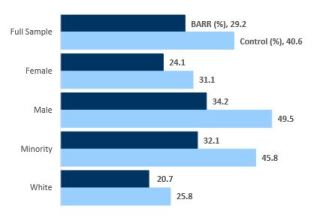Creating bridges among teachers may help keep high school students from slipping through the cracks.
That’s one takeaway from a new evaluation validating Building Assets, Reducing Risks, a program intended to ease students’ transition to high school. The American Institutes of Research found the program, which couples intense teacher collaboration with student social-emotional supports, significantly improved 9th graders’ academic progress and connection to school.
Under BARR, incoming freshmen are grouped into cohorts of about 30 students who take the same reading, math, and science classes together. They also receive a 30-minute lesson each week on social-emotional skills, taught on a rotating basis in a core class. Teachers meet every week for a check-in on every student in their cohort, evaluating weekly progress on both academic and social-emotional goals.
AIR randomly assigned more than 4,000 students at 11 high schools in five states to either BARR or the normal freshman class assignment. It found students who participated in the Building Assets, Reducing Risks program had higher grade point averages than students in the control group—2.58 out of 4.0 versus 2.48— and BARR students were also significantly less likely to fail a course in 9th grade:

Outside of BARR, students of color were 20 percentage points more likely than white students to fail at least one course in 9th grade, while in BARR, the gap was only 11 percentage points. There were no differences in NWEA reading or math test scores in the current study, though prior studies had found the BARR students performed slightly better than students in the control group.
Students in BARR also were more likely than those in the control group to say they had supportive relationships with teachers at their school, and they believed their teachers had higher expectations for them.
Johannes Bos, a senior vice president at AIR who led the BARR evaluation, suggested the gains were being driven by teachers working together more closely. “Looking at the implementation of BARR, it seems like the most critical distinguishing factor is the improved collaboration among teachers. “That’s where it starts,” he said, “and then from that you get better relationships between teachers and students.”
Stronger Teacher Collaboration
Most elementary teachers see their charges all day, making it easier to spot small problems accumulating for students. But high school teachers may see a student only once a day, or a few times a week, making sharing information critical to spotting patterns.
“High schools have just been overly departmentalized, especially these really large high schools. And as a result, you can lose the partnership element between departments,” Bos said. The study found 57 percent of BARR teachers favored working with their colleagues, compared to only 45 percent of teachers who were not in the program.
Angela Jerabek, a former 9th grade guidance counselor who founded BARR, said the program has had to add more detailed professional development for teachers after schools moved beyond basic implementation. While early training in the program focused mainly on understanding student data and the structure of team meetings, the schools that use the program have since developed a network to share problems and ideas.
“It’s really exciting to have so many different schools in so many different environments that I don’t think typically would be in the same room together, to be actively in dialogue and learning from each other,” Jerabek said.
There were no significant benefits for BARR students in chronic absenteeism, suspensions, or persistence in high school, though students in the program reported higher engagement. While the study found schools of all sizes showed improvement from implementing the program, the benefits were stronger in larger and more urban schools. Bos suggested that small schools may be more likely to have close teacher collaboration already, without the training.
AIR will look at more long-term effects of the program in an ongoing scale-up study expected in 2021.
Chart Source: American Institutes of Research
Related:



